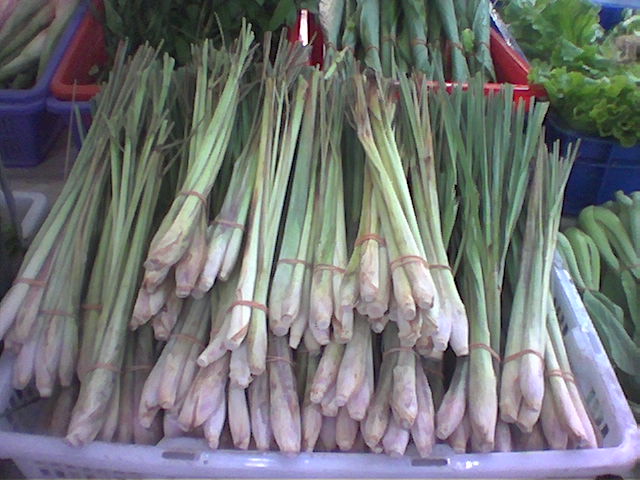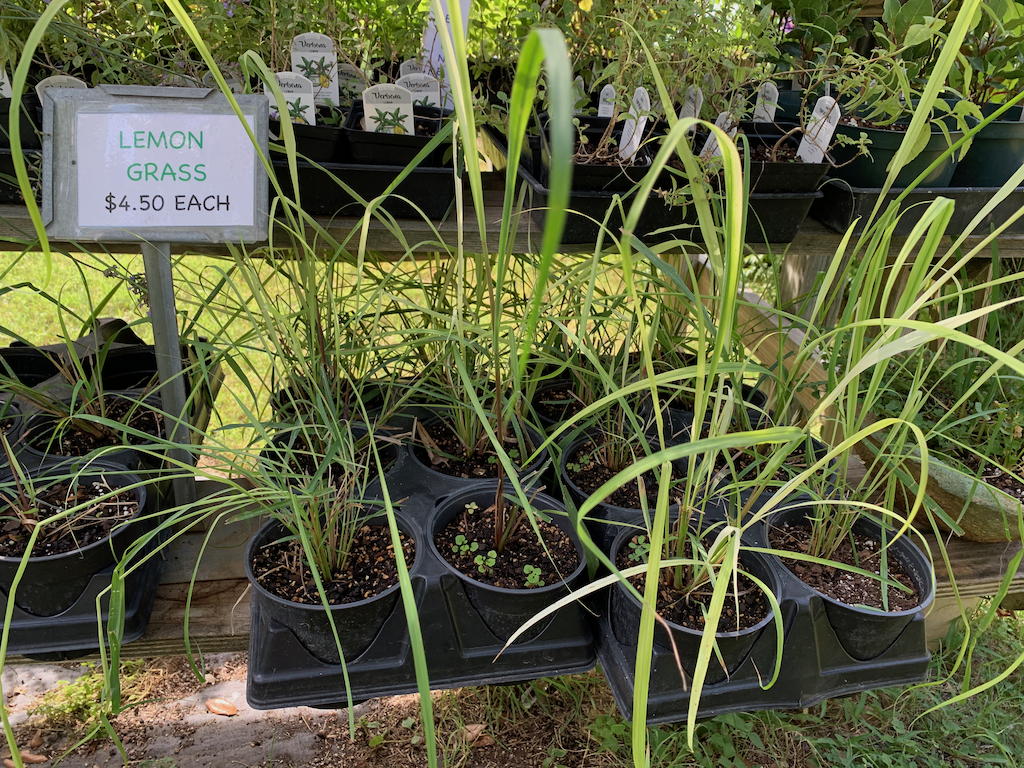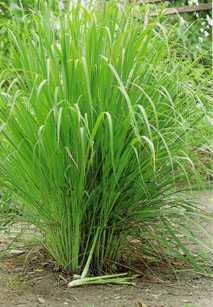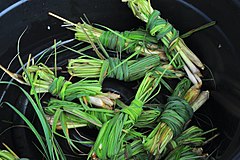- Botanical Name: Cymbopogon citratus (sim-bo-PO-gon si-TRA-tus)
- Family: Poaceae (Gramineae) (Grass)
- Hardy in Zones 8 – 10. Note: I am in Zone 9a and have lost lemongrass over the Winter. Most years the tops freeze back and new shoots emerge from the root zone when the soil warms up sufficiently. But, not always. So, if you live in an area where the hardiness is questionable, grow your lemongrass in a pot and protect it during the Winter.
Lemongrass is a tropical grass native to India and Southeast Asia. It has ornamental, culinary, cosmetic and medicinal value. It likes lots of sun and water. Even here in Texas where many plants wilt in our hot late summer sun, Lemongrass thrives, given enough water.
It is a clumping type fountain grass. It is not a running type grass, so it is non-invasive. The clump can grow 3 – 4 feet across and up to 5 feet tall. Attractive in containers, it can be grown anywhere as an annual. Use it in combination planters for its dramatic effect. Protect it during the Winter for continued growth. It certainly can be grown as a houseplant with good drainage and lots of light.
One caution: the blades are very sharp, as with many grasses… that’s why they call them blades! So, when pruning or tending to your Lemongrass, gloves are useful. Always rub the leaf from the bottom up to prevent being cut by the blade.
Ornamental
Lemongrass is useful as a landscape grass in frost free areas. In colder areas, its fast summer growth allows it to be used as a garden accent and filler. The leaves of a healthy Lemongrass plant are bright green and blend well with most any garden situation. For most gardeners, Lemongrass will not flower and produce seed.
Occasionally, in frost free areas, you might see some attractive airy flower heads which turn into seeds. I have never had Lemongrass seed out from seed growth, bt I find the tall flowers stalks and succeeding seed heads add interest to the garden.
Insect Repellent Properties
In pots or in the garden around a patio or deck, Lemongrass can help repel mosquitoes. The essential oils citral and citronella have shown to be effective as insect repellent.
Citral is the key component that gives the lemony aroma and taste in several herbal plants such as Lemongrass (Cymbopogon citratus), Lemon Balm (Melissa officinalis) and Lemon Verbena (Verbena officinalis. )
One study conducted in 2013 used steam distillation to extract the essential oils of Lemongrass. Those oils were added to candy, which was used as bait to attract ants. One piece of candy has the Lemongrass extract, the other did not. Within 14 minutes ants came to the plain candy, while completely avoiding the candy with the Lemongrass extract.
While a preparation made with Lemongrass extract applied to the skin and clothes would be most effective, having the plants around an outdoor seating area could help keep those pesky mosquitoes away. And, if from time to time, you were to brush or disturb the Lemongrass more of the scent would be released into the air.
Culinary
Delectable dishes from Southeast Asia often use Lemongrass. Various chicken and seafood preparations are flavored with the lemony flavor of Lemongrass. The part that is used is the firm lower part of the stem. The whole stem is cut at the soil line, the leafy parts are trimmed off and the rest is used to flavor food.
Knots of Lemon Grass used in Philippine cuisine.
The stem is crushed or pounded and added in large pieces during the cooking process. Then, the pieces are removed so they are not eaten. A 2 – 4 inch piece of Lemongrass will impart a very lemony flavor to a stir-fry. Try placing a crushed piece of Lemongrass stem in a pot of rice using chicken broth instead of water and cook as usual. You will have a lovely, lemony rice to serve with chicken or seafood! Add some Lemongrass to a chicken soup for an Asian twist on an old favorite. Just don’t forget to remove the thick pieces of the stem before serving!!
The leafy parts of the Lemongrass stalk can be used to make a delicious and refreshing tea. You can use the leaves fresh or dried. If fresh, use about 2 teaspoons chopped leaf per cup of tea. If dried, use about 1 teaspoon per cup. Lemongrass blends well with green tea, chamomile, mint, rose hips, hibiscus and holy basil. I find a blend of Lemongrass and mint to be a most refreshing iced tea on a hot afternoon. Experiment with blends from your own herb garden.
Here is a refresher on making herb tea.
The following recipe is from my friend Linda Collins of Rockport, TX.
TOM KA GAI
(Chicken coconut soup)
- 1 cup unsweetened coconut milk
- 1 cup chicken broth
- 3 to 4 thin slices galangal root (some recipes substitute ginger, but others say absolutely do not substitute)
- 3 kefir (kaffir) lime leaves
- 1 stalk lemongrass, lower portion cut into 1-inch lengths and crushed
- 6 straw mushrooms
- 4 ounces chopped chicken
- 1 tablespoon sugar
- 1 teaspoon salt
- 3 tablespoons lime juice
- Cilantro
- Ground chili powder (optional)
In saucepan, combine coconut milk, chicken broth, galangal, kefir lime leaves, lemongrass and straw mushrooms and heat over medium until boiling. Add chicken; simmer about 2 minutes, or until chicken is cooked. Mix in sugar, salt and lime juice. Garnish with cilantro. If desired, add ground chili powder to achieve desired spiciness. Makes 2 servings.
Cosmetic
The essential oil of Lemongrass is one of the 10 most produced essential oils worldwide. It is used in many scents, soaps, lotions and other skin and hair preparations. It is blended with other oils to produce a lemon scent.
Medicinal

Lemongrass harvested and bundled for market. You can see the leafy parts have been cut off.
In areas where Lemongrass grows natively, it is used in many ways for health and well-being. The essential oil is often mixed with coconut oil and rubbed on arthritic joints and sore muscles. A bath with the essential oil of Lemongrass added can ease sore muscles.
If you don’t have the essential oil handy, a strong Lemongrass tea added to a bath will achieve similar results. The tea can also be used as a compress for bruises and soreness.
It is not only psychologically refreshing, but it is said to serve as a tonic for tightening weak connective tissue. The essential oil strengthens blood vessels and helps prevent varicose veins.
There is some evidence that Lemongrass can be used in cancer treatments. A study at an Israeli hospital, Ben Gurion University, has found the component Citral, one of the active oils in Lemongrass, caused cancer cells to “commit suicide” in a test tube.
“According to Ofir, the study found that citral causes cancer cells to ‘commit suicide: using apoptosis, a mechanism called programmed cell death.’ A drink with as little as one gram of lemon grass contains enough citral to prompt the cancer cells to commit suicide in the test tube.
The BGU investigators checked the influence of the citral on cancerous cells by adding them to both cancerous cells and normal cells that were grown in a petri dish. The quantity added in the concentrate was equivalent to the amount contained in a cup of regular tea using one gram of lemon herbs in hot water. While the citral killed the cancerous cells, the normal cells remained unharmed.
The findings were published in the scientific journal Planta Medica, which highlights research on alternative and herbal remedies. Shortly afterwards, the discovery was featured in the popular Israeli press.”
Apparently, after the article came out in the Israeli press, a Lemongrass farm in Israel started to be swamped with visitors looking for Lemongrass to grow for themselves. Lemon Grass for Cancer
Whether you like the look of Lemongrass in your landscape, grow it for its Culinary, Cosmetic or Medicinal purposes, Lemongrass will add to your herbal and garden collection.

QUOTE FOR THE MONTH
The more sand that has escaped from the hourglass of our life, the clearer we should see through it.
-Jean-Paul Sartre, writer and philosopher (1905-1980)


